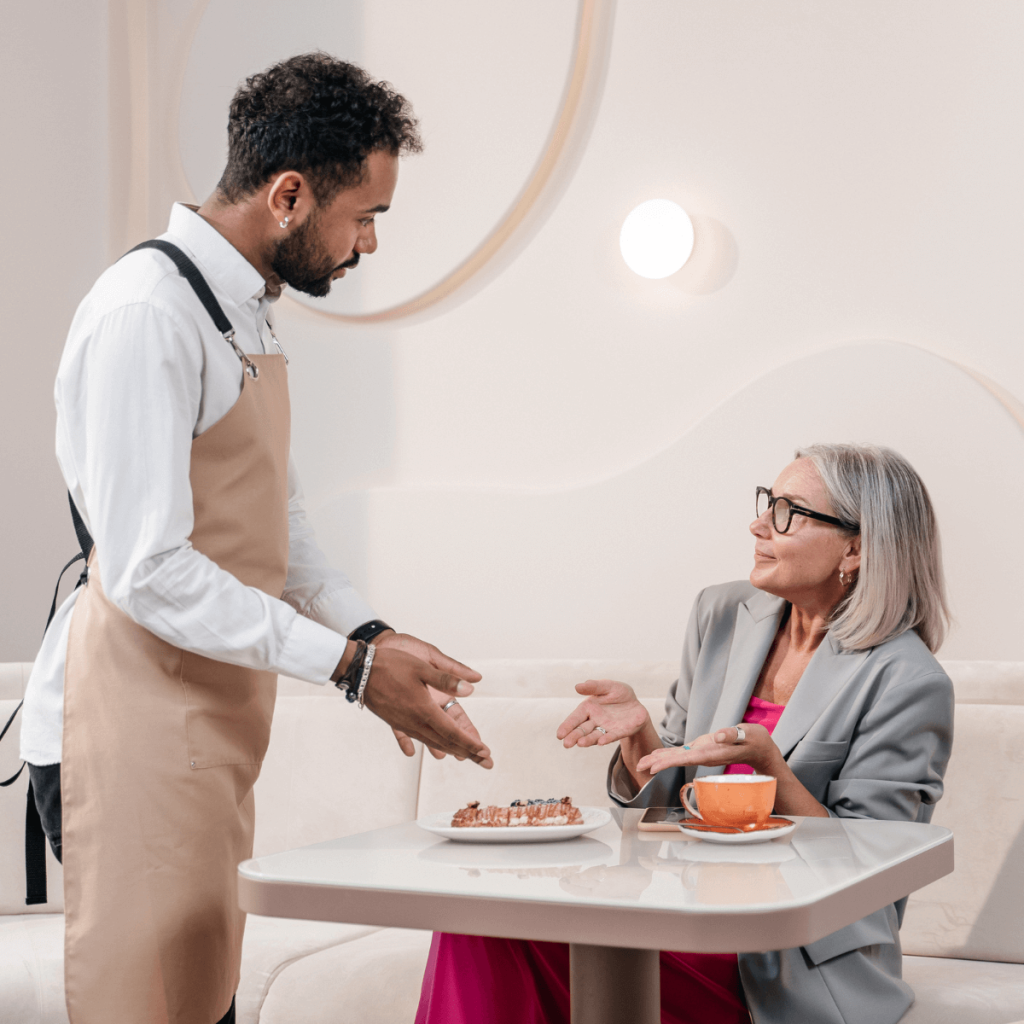Ever had that heart-dropping moment when a customer approaches you with a complaint? It’s a scene many of us know all too well, and learning how to handle customer complaints effectively can feel like a daunting task. But what if we told you that this feeling doesn’t have to be stressful? Instead, it can be your ticket to growth and success.
Effective customer complaint handling isn’t just about putting out fires; it’s about building trust and turning a negative customer experience into a chance for positive repeat business. In this blog, we’ll dive deep into actionable steps that will empower you to tackle complaints head-on like a pro.
Learn how to:
Actively listen to your customers
Validate their feelings
Offer solutions that not only fix the problem but also exceed expectations
We’ll guide you through each step with practical tips and examples, ensuring you can turn a potentially damaging situation into loyal customers and advocates for your brand. Let’s shift the narrative from fear to power and turn complaints into growth!

Why Customer Complaints Are Your Golden Ticket
Complaints will happen. Even the best teams, menus, and systems aren’t immune. However, what truly elevates your restaurant or hotel from simply ‘good‘ to ‘great‘ is how your team responds when things go wrong. This is where mastering how to handle customer complaints becomes your competitive edge.
When a customer complains, they’re giving you something powerful: a second chance. A chance to fix the issue, exceed expectations, and build customer loyalty.

In hospitality, we don’t just serve food or provide the keys to a room; we serve experiences. Experiences are shaped not just by what goes right, but also by how we handle customer complaints.
Understanding the Upset Guest: Emotional Intelligence in Action
Before we can fix something, we first need to understand what’s gone wrong. Having empathy and understanding of your guest’s expectations will be what gets you from a state of chaos to a moment of calm. It’s not enough to hear a complaint; you must identify the underlying emotions and unmet needs that drive it. If you’re a restaurant or hotel manager, honing this skill in your team for customer complaint resolution is essential. Teaching them how to handle customer complaints effectively starts with empathy.

When a customer complains, what they say isn’t always the whole story. Often, beneath the surface of a specific issue – a cold dish, a noisy room, a long wait – lie negative emotions. Train your team to recognise these common triggers:

Frustration
This is often the first layer of concern. Guests usually become frustrated when their expectations or the services they pay for are not met. This can stem from delays, system glitches, or repeated issues.

Disappointment
This goes deeper than simple frustration. Guests feel let down, mainly if the experience was meant to be special (like an anniversary dinner or a needed holiday). Disappointment often comes from a broken trust or a ruined idea of what their guest experience should have been.

Feeling Unheard/Ignored
This is a common trigger for bigger problems. If guests have already tried to speak up or feel their complaint was overlooked, they’ll feel your team isn’t taking their needs seriously.

Embarassment
Some guests feel awkward or embarrassed to complain, especially in public. This can lead to passive-aggression or a sudden outburst once they finally speak up.
To effectively handle guest complaints, it’s essential to understand the emotions behind them. Encourage your team to practice active listening and empathy, as this approach addresses both the immediate issues and the emotional needs of your guests. Empower your staff to acknowledge feelings, offer sincere apologies, and take proactive steps to resolve problems.
The L.A.S.T. Method: How to Handle Customer Complaints in 4 Steps
Once you understand a guest’s feelings, it’s time to act. The L.A.S.T. method is a clear way to fix problems and build loyalty. But to truly turn a complaint into a loyalty moment, your team needs to understand the psychology behind each letter, moving beyond mere steps to a genuine human connection.

L – Listen: The Power of Active Understanding
Active listening dives deeper than simply hearing. Discuss active listening techniques with your team, such as reflective listening and allowing customers to express themselves fully without interruption.
Scenario: A hotel guest, Mr. Harrison, is visibly annoyed at the front desk. Front Desk Agent (Mark): “Good evening, Mr. Harrison. Is everything alright?” Mr. Harrison: (Frustrated) “No, the air conditioning in my room, 307, isn’t working at all! It’s boiling, and it’s been an issue on and off all day!“
Mark’s Active Listening Techniques:
Non-Verbal: Mark stops what he’s doing, turns to face Mr Harrison, maintains eye contact, and nods empathetically.
No Interruptions: He lets the guest finish talking.
Paraphrasing & Validating: “So, if I understand, the AC in Room 307 is completely out, making it uncomfortably hot, and this isn’t the first time it’s happened today? I can see how frustrating and uncomfortable that must be.”
Mr. Harrison: (Calming slightly) “Exactly!“
Mark: “You’re right, and I sincerely apologise for this. Let’s get this sorted for you immediately…“
Want to learn more about active listening? We recommend 7 Active Listening Techniques for Better Communication.

A – Apologise: Acknowledge Experience, Rebuild Trust
The power of a sincere apology has positive ripple effects. Explain to your team that it’s about acknowledging the customer’s experience, not necessarily admitting fault. Differentiate between a genuine apology and a robotic one.
Scenario: A cafe customer, Miss Chen, has just received her coffee and cake. She asked for a large cappuccino with oat milk and a slice of carrot cake. She gets a regular cappuccino with whole milk, and no carrot cake arrives. Frustrated and now in a rush, Miss Chen approaches the barista to complain.
Barista (Sarah): (After actively listening and understanding Ms. Chen’s frustration with the incorrect order) “Ms. Chen, I am truly sorry that your order is not as you requested, which is now causing you to be late for your meeting. This is not the standard we aim for, and I understand how frustrating it is when your order isn’t right.“
Why Sarah’s Apology is Effective:
Sincere Tone: “I am truly sorry” conveys genuine regret.
Acknowledges the Customer’s Experience: “Your order is not as you requested, which is now causing you to be late for your meeting.” directly addresses the customer’s personal negative experience and emotional state. It doesn’t just say ‘sorry for the mistake.’
Validates the Customer’s Feelings: “I understand how frustrating it is,” shows empathy and lets the customer know her feelings are recognised.
Takes Responsibility (without making excuses): “This is not the standard we aim for,” acknowledges the lapse in hospitality service standards without going into a lengthy explanation or blaming individual team members.
Focuses on the Customer, Not the Problem Itself: The apology centres on the customer’s experience of the problem, rather than just the incorrect order.

S – Solve: From Frustration to Trust
Empower your team to find solutions. Discuss creative problem-solving, offering options, and when to involve management. Emphasise making the guest feel part of the solution.
Scenario: Miss Jennings, a guest in Room 503, finds that her in-room coffee pods and sugar have not been replenished. She approaches Karolina, a housekeeper, who has listened and apologised. “Oh, Miss Jennings, I am so sorry about that! I understand how frustrating it is when your room amenities aren’t replenished. Please accept my sincerest apologies.“
Here’s How Karolina Effectively Offers a Solution:
Immediate Action: Karolina immediately walks to her cart. “I’ll get those for you right away. Let me grab a few extra to ensure you’re well stocked for the next couple of days.“
Proactive Care: While at the cart, she also grabs a newspaper. Karolina returns with the items. “Here are your coffee and sugar, and a copy of today’s newspaper for you. Please don’t hesitate to call if you need anything else.“
Outcome: Miss Jennings’s problem is quickly resolved, and Karolina’s thoughtful extra effort with the newspaper enhances her overall positive experience, making her feel valued. This is a prime example of effective customer complaint handling, showcasing precisely how to handle customer complaints with practical solutions.

T – Thank: Turning Feedback into Future Loyalty
Thank customers for bringing the issue to your attention. Explain how this reinforces their value and encourages future feedback, boosting customer retention.
Scenario: Mr. and Mrs. Martinez have just finished their anniversary dinner. Earlier, Mrs. Martinez had complained that they had to wait 30 minutes for their table because of overbooking. Their waiter, Paolo, had listened, apologised, and swiftly resolved the issue by relocating the couple to a more desirable area in the bar. He then offered them a complimentary drink while they waited for their table to become free.
How Paolo’s Thank You Ensures Repeat Custom:
Paolo: (Smiling genuinely as he places the bill down) “Mrs. and Mr. Martinez, I hope you enjoyed the rest of your anniversary dinner here with us.“
Mrs. Martinez: “Yes, thank you, Paolo. The meal was perfect, and we appreciated the drinks whilst you saw to our table. You handled everything so well.“
Paolo: “That’s wonderful to hear, Mrs. Martinez. I’m glad we were able to turn things around for you. And honestly, thank you so much for bringing the issue with the wait to my attention. We truly rely on customer feedback to ensure our dining experience is always at its best, and it allowed us to ensure your special evening was perfect in the end. We truly appreciate you giving us that opportunity.“
By thanking them, Paolo is building a relationship where Mr. and Mrs. Martinez not only feel comfortable returning but are more likely to offer feedback again if needed. This is key to guest satisfaction.

Empowering Your Front-of-House Team: Mastering Customer Complaint Resolution
Seamless service recovery comes down to two things: setting clear rules and training your hospitality team on how to handle customer complaints on their own steam.
1. Autonomy and Authority
One key element in creating a productive work environment is giving your team the freedom to fix problems fast. When staff can make quick choices, it speeds up solutions and makes customers happier.
When employees feel empowered, they are more likely to take ownership of their roles and aim to provide the best service possible. To enable employees, set clear boundaries and guidelines. Identify which decisions they can make on their own and when they should involve a manager. This clarity helps them feel confident in their ability to act without worrying about overstepping.
With the right balance of autonomy and guidance, employees can respond to challenges with greater confidence and flexibility.
2. Training Beyond the Script
Customer service training often falls into the trap of teaching new team members to follow scripts without understanding the reasons behind the concept. While having a script can be beneficial in providing basic guidelines, it is vital to move beyond this approach.
The goal of training should be to foster genuine understanding and adaptability. When we invest in training that encourages critical thinking, staff can better handle unexpected situations. For instance, rather than just memorising phrases for customer interactions, team members should grasp the reasons behind the processes.
This can be achieved through interactive sessions, discussions, or workshops. By fostering a culture where employees feel informed and equipped to make decisions based on their understanding, companies can promote a more agile workforce.
3. Role-playing and Real-life Scenarios
Practical hospitality training methods, such as role-playing and real-life scenarios, can boost an employee’s confidence and skills in conflict resolution.
In role-playing exercises, team members can practice how to handle different situations they might face at work, from dealing with challenging customers to managing complex processes. This hands-on experience reinforces what they’ve learned and allows employees to get constructive feedback.
Additionally, using real-life scenarios in training helps staff apply their knowledge in a safe environment. This type of immersive learning encourages employees to develop problem-solving abilities and promotes teamwork.
Explore more ways to create a productive work environment in our article Lead with Heart: Leadership Skills to Inspire and Motivate.

The Long-Term Value: From Complaint to Loyalty
Every customer complaint is an opportunity. It’s your chance to fix issues and strengthen relationships. This concept is known as the Service Recovery Paradox. When you address a problem quickly and effectively, customers often become even more satisfied and loyal than they would have been if everything had gone smoothly from the start.
A satisfied guest isn’t just a returning customer; they become your most powerful marketer. They’ll share their positive stories, singing your praises through authentic word-of-mouth marketing that even in today’s transactional world, money can’t buy. Let’s be clear: ignoring complaints is a costly mistake. Unresolved issues don’t just vanish; they fester, leading to lost business, a tarnished reputation, and a breakdown of trust.
By focusing on effective service recovery, you’re not just solving problems; you’re building a loyal customer base that promotes business growth. This approach helps you rise above standard service and become exceptional, which is essential in today’s competitive landscape. This directly impacts your customer lifetime value.

Ready to Transform Your Service with a 5-Star Team?
Looking for a team that doesn’t just resolve issues but builds lasting loyalty with every interaction?
We have excellent candidates ready to elevate your customer experience, handling service recovery like true pros. They’re equipped with the emotional intelligence and problem-solving skills to turn any complaint into a 5-star moment.
